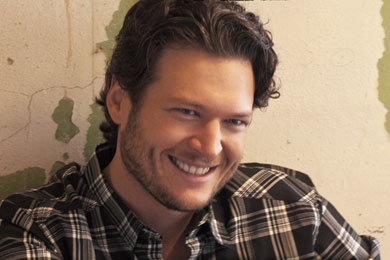
This year’s post-Academy of Country Music Awards sales showed little, if any, overall sales bump (week ended 4/10/2011) according to Nielsen SoundScan. Country album sales inched a meager 1% over the previous week. However, Warner’s Blake Shelton, who debuted “Honey Bee” on the show and co-hosted with Reba, was a notable exception. His new single lodged firmly at No. 1 on the country digital tracks chart selling almost 139k downloads, more than double the sales of the No. 2 track. Shelton, also posted six additional country digital tracks in the Top 100 all of which showed growth from the previous week of 10%-135%. “Honey Bee” is now the highest selling debut single by a country male soloist—ever.
“Singles often take big jumps based upon TV,” says Warner Music Nashville Sr. VP Brand Management and Sales, Peter Strickland. “Even when a track is played within the context of a show and not necessarily only with a performance, we see big digital spikes.”
Digital tracks usually have a Tuesday debut, but this writer noticed that immediately after Shelton’s Sunday night ACM debut, an email arrived alerting that the song was available at iTunes for purchase. Clearly, a plan was in place. And when SoundScan revealed the single’s impressive sales results, we wanted to find out more. MusicRow “tracked” Strickland while on the road in New York City where he graciously shared some of the behind-the-scenes elements leading to Blake’s strong showing.
 “The timing was perfect for a premiere on the ACMs,” explains Strickland. “It gave us some breathing room after the last single to lead into a new single from a new project. Once the performance was confirmed on the ACMs we began building our plan. Knowing how people react to a TV appearance, performance or a song being featured we said, ‘This song has to be available digitally at the same time that the performance takes place.’ We went to our partners and gave them the opportunity to have the track available ‘off cycle’ which would be anything other than a Tuesday.”
“The timing was perfect for a premiere on the ACMs,” explains Strickland. “It gave us some breathing room after the last single to lead into a new single from a new project. Once the performance was confirmed on the ACMs we began building our plan. Knowing how people react to a TV appearance, performance or a song being featured we said, ‘This song has to be available digitally at the same time that the performance takes place.’ We went to our partners and gave them the opportunity to have the track available ‘off cycle’ which would be anything other than a Tuesday.”
Strickland notes, “It was delicate because radio wouldn’t have the single either. So the add date was based around the TV show as well. We delivered the song to radio on Sunday just before the performance, so they could immediately play it. Everything was timed around the performance and making the single available for people to buy. Part of the strategy was that if I could get Blake into the Top 10 overall digitally it puts him on the front page everywhere and then the curiosity factor happens. You know Katy Perry is No. 1 and Blake is No. 2 or 3. People ask, ‘Who is that guy?’ People shop off of the chart.
“All our online strategy was put in place as well. We bought advertising online, engaged the socials, the email database and put some of the older tracks on sale. We actually treated the single like we would a full length album release. We went out and bought TV spots in the Top 10 Blake Shelton markets advertising the single during the show. So people saw the performance and then heard, ‘You Can Buy It Now.’ Those things are hard to measure. If we didn’t buy TV advertising would we still have been at that number? It is hard to say. But taken collectively, it gave us a huge debut, and continued Shelton’s momentum growth.”
All marketers would rather sell an album unit with its higher revenue/profit as compared to a track unit. But with album sales, and the shelf space the physical portion of those sales require, shrinking faster than an over-dried Wal-Mart t-shirt the question arises: Are we entering a new phase for track strategy? “Digital singles are funny,” says Stickland. “You usually release them without a mass audience which means you are not going to have a big first week. It’s not treated like an album in the sense of getting the record all the way up the charts to reach critical mass before making it available in order to get big first week numbers. But we have to figure out how to do things differently. Treating this single as we would an album was a new way of thinking. We are still collecting pennies, but at the end of the day it’s going to lead to a bigger place. It might be an early upfront investment on the full length release in the future or maybe it is about selling five to seven million singles. Either way I’m not going to try and stop the consumer. I want to learn from their habits and hopefully give them more of what they want, when they want it.”
Over a year ago when WMG announced they would release a series of six track album packages on Shelton, there was a lot of marketplace discussion, not all positive. But Shelton’s star has undeniably risen and he’s received an avalanche of publicity. “It was March 2010 when we released the first six pak and wanted to do something different for Blake,” says Strickland. “It appears our decisions were fruitful in many areas, especially increasing Blake’s overall exposure in the marketplace. His appearance on The Voice is a tribute to this career building. Putting him in front of the country consumer and the fringe country consumer has created opportunities. Finally, people have had the opportunity based upon the number of press hits he’s had in the last 12 months to see his personality in addition to the music that he delivers to his base. If you are going to grow a career you have to hit that fringe audience.”
Can treating a single release as if it were a full album make economic sense in some way? “Yes,” says Strickland. “If you aren’t careful with the spend you can be losing money, but at the end of the day it is an investment and part of the marketing strategy for our format’s artists and the various revenue streams they produce. As an industry, we are investing in the artists and more than just record sales.”

Category: Artist, Featured, Sales/Marketing
About the Author
David M. Ross has been covering Nashville's music industry for over 25 years. dross@musicrow.comView Author Profile



